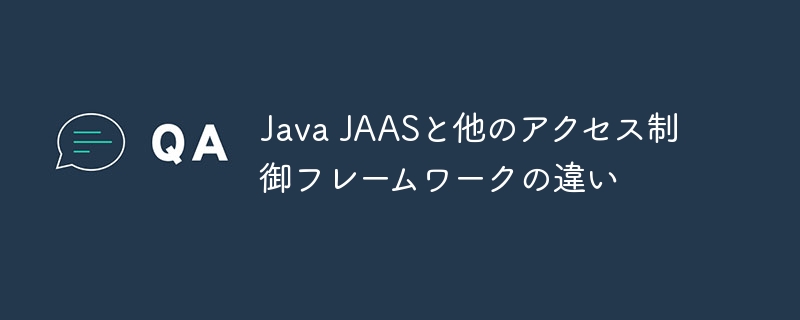Differences between Java JAAS and other access control frameworks

php editor Youzi will introduce to you the difference between Java JAAS and other access control frameworks. Java JAAS is the abbreviation of Java Authentication and Authorization Service. It is a security framework provided by Java for authentication and authorization control. Compared with other access control frameworks, Java JAAS has its own unique features in achieving flexibility and security. When using Java JAAS, developers can more conveniently manage user authentication and access rights, improving system security and controllability.
-
Centralized Security Management: JAAS allows applications to manage security settings in a unified manner without having to worry about the details of the underlying implementation.
-
Pluggable authentication and authorization mechanisms: JAAS supports multiple authentication and authorization mechanisms, including:
- Username and password based authentication: This is the most common authentication mechanism that requires the user to enter a username and password.
- Certificate-based authentication: This is a more secure authentication mechanism that requires the user to provide a digital certificate.
- Token-based authentication: This is a lightweight authentication mechanism that requires the user to provide a token.
- Biometric-based authentication: This is a more secure authentication mechanism that requires the user to provide biometric information, such as a fingerprint or iris scan.
-
Fine-grained access control: JAAS allows applications to perform fine-grained access control to resources. It supports multiple access control models, including:
- Role-Based Access Control (RBAC): RBAC is a common access control model that allows applications to control access to resources based on the user's role.
- Attribute-Based Access Control (ABAC): ABAC is a more flexible access control model that allows applications to control access to resources based on the user's attributes.
The following is a code example that demonstrates how to use JAAS for authentication and authorization:
import javax.security.auth.Subject;
import javax.security.auth.login.LoginContext;
public class JAASExample {
public static void main(String[] args) {
// Create a login context.
LoginContext loginContext = new LoginContext("SampleLoginModule");
// Login the user.
loginContext.login();
// Get the subject.
Subject subject = loginContext.getSubject();
// Check if the user is authorized to access the resource.
if (subject.isAuthorized(new ResourcePermission("resource1", "read"))) {
// The user is authorized to access the resource.
System.out.println("Access granted.");
} else {
// The user is not authorized to access the resource.
System.out.println("Access denied.");
}
// LoGout the user.
loginContext.logout();
}
}This tutorial introduces the basic concepts and usage of Java JAAS. JAAS is a framework in Java for implementing security authentication and authorization functions. It provides a unified interface to interact with a variety of different authentication and authorization providers, simplifying the development of security applications.
The above is the detailed content of Differences between Java JAAS and other access control frameworks. For more information, please follow other related articles on the PHP Chinese website!

Hot AI Tools

Undresser.AI Undress
AI-powered app for creating realistic nude photos

AI Clothes Remover
Online AI tool for removing clothes from photos.

Undress AI Tool
Undress images for free

Clothoff.io
AI clothes remover

AI Hentai Generator
Generate AI Hentai for free.

Hot Article

Hot Tools

Notepad++7.3.1
Easy-to-use and free code editor

SublimeText3 Chinese version
Chinese version, very easy to use

Zend Studio 13.0.1
Powerful PHP integrated development environment

Dreamweaver CS6
Visual web development tools

SublimeText3 Mac version
God-level code editing software (SublimeText3)

Hot Topics
 Square Root in Java
Aug 30, 2024 pm 04:26 PM
Square Root in Java
Aug 30, 2024 pm 04:26 PM
Guide to Square Root in Java. Here we discuss how Square Root works in Java with example and its code implementation respectively.
 Perfect Number in Java
Aug 30, 2024 pm 04:28 PM
Perfect Number in Java
Aug 30, 2024 pm 04:28 PM
Guide to Perfect Number in Java. Here we discuss the Definition, How to check Perfect number in Java?, examples with code implementation.
 Random Number Generator in Java
Aug 30, 2024 pm 04:27 PM
Random Number Generator in Java
Aug 30, 2024 pm 04:27 PM
Guide to Random Number Generator in Java. Here we discuss Functions in Java with examples and two different Generators with ther examples.
 Armstrong Number in Java
Aug 30, 2024 pm 04:26 PM
Armstrong Number in Java
Aug 30, 2024 pm 04:26 PM
Guide to the Armstrong Number in Java. Here we discuss an introduction to Armstrong's number in java along with some of the code.
 Weka in Java
Aug 30, 2024 pm 04:28 PM
Weka in Java
Aug 30, 2024 pm 04:28 PM
Guide to Weka in Java. Here we discuss the Introduction, how to use weka java, the type of platform, and advantages with examples.
 Smith Number in Java
Aug 30, 2024 pm 04:28 PM
Smith Number in Java
Aug 30, 2024 pm 04:28 PM
Guide to Smith Number in Java. Here we discuss the Definition, How to check smith number in Java? example with code implementation.
 Java Spring Interview Questions
Aug 30, 2024 pm 04:29 PM
Java Spring Interview Questions
Aug 30, 2024 pm 04:29 PM
In this article, we have kept the most asked Java Spring Interview Questions with their detailed answers. So that you can crack the interview.
 Break or return from Java 8 stream forEach?
Feb 07, 2025 pm 12:09 PM
Break or return from Java 8 stream forEach?
Feb 07, 2025 pm 12:09 PM
Java 8 introduces the Stream API, providing a powerful and expressive way to process data collections. However, a common question when using Stream is: How to break or return from a forEach operation? Traditional loops allow for early interruption or return, but Stream's forEach method does not directly support this method. This article will explain the reasons and explore alternative methods for implementing premature termination in Stream processing systems. Further reading: Java Stream API improvements Understand Stream forEach The forEach method is a terminal operation that performs one operation on each element in the Stream. Its design intention is






